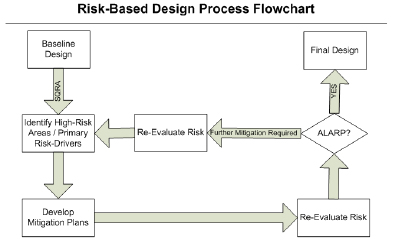RISK BASED ASSESSMENT OF PIPELINE DESIGN
Description
A rigorous pipeline design assessment, or pipeline consequence assessment, process that goes beyond the minimum requirements of codes and regulations to identify potential future operating risks relating to a proposed new pipeline. Pre-emptive measures and strategies to address the principal drivers of these risks are evaluated for incorporation within the final design to reduce the likelihood and/or consequences of a pipeline operating failure. Risk can be managed to a threshold of diminishing returns (As Low As Reasonably Practicable), whereby the resources required to implement risk reduction measures are evaluated proportionate to the benefits of the resulting risk reduction that would be achieved, (See Figure 1).

Methodolgy
The pipeline industry has moved towards adopting reliability methods, initially developed and used in the aerospace and nuclear industries, for managing risk and increasing reliability. Pipeline industry organizations such as PRCI and EPRG have funded research to develop reliability-based models for various threats for pipeline systems. Reliability models employ limit state functions for the specific damage mechanism of interest in which the load variables and resistance variables are characterized in terms of probability density functions.
Limit state functions exist for the most significant threats; i.e. 3rd Party Damage and corrosion (both internal and external). Geo-hazards (both geotechnical and geological), if identified as significant threats, can be evaluated by an expert assessment at discrete locations of potential susceptibility in order to characterize the magnitude and associated frequency of occurrence of these threats.
Areas of higher risk are identified and given increased priority for the implementation of additional risk mitigation measures. Such measures act to reduce risk by targeting the primary threats (thereby lowering failure likelihood) and/or consequences at local discrete locations of higher risk.
Examples of identified risk and mitigation actions are as follows:
- Mitigation of 3rd Party Damage through review of urban planning projections, application of deeper burial depth, use of buried warning tape or use of increased wall thickness.
- Mitigation of geo-hazards through threat avoidance, or the mitigation of consequence through the optimization of valve placement design.
- Mitigation of external corrosion through evaluation of cathodic protection design, external coating testing parameters, coating field application processes, construction procedures and qualification of field personnel.
Benefits:
- Addresses the likelihood of failure, the consequence of failure, and the ability (or lack thereof) of detecting conditions leading to failure; focusses on safety and reliability as a design best practice.
- Identifies the principal risk-drivers in high-risk pipeline segments, allows for pre-emptive selection of appropriate risk-mitigation plans to address those principal risk-drivers.
- Identifies protective and mitigative measures that can be applied within the design process according to the identified hazards and the risks that are present; avoids wasting resources due to over-specified requirements; allows for design optimization leading to the reduction in levels of conservatism while maintaining acceptable levels of risk.
- Considers risk of failure due to “what if” deviations from normal operating conditions.
- Addresses specific operating variables where design code applications are not fully applicable to define and control risks.
Deliverables:
- A final verification report that the pipeline that provides:
- A description of the methodology and the method applications within the risk based design verification process.
- A summary of findings relative to potential risks and pipeline design considerations; a prioritization of identified risks.
- Recommended pre-emptive measures and strategies to address the principal drivers of identified risks.
Related Support Services
- Pipe Manufacturing – Verification of line pipe manufacture with project design (material) specifications and elements of risk based design.
- Inspection procedures, test plans and record keeping
- Manufacturing Procedures
- Manufacturing Schedule
- Line Pipe Coating – Verification of line pipe coating with project design specifications and elements of risk based design.
- Inspection procedures, test plans and record keeping
- Manufacturing Procedures
- Manufacturing Schedule
- Pipeline Construction and Installation Verification – Verification of compliance of construction and installation plans, reporting and procedures with project design specifications and elements of risk based design.
- Construction Specifications
- Inspection and Test Plans
- Inspection Reporting
- Manufacturing Schedule
- Construction Record Keeping
- Pipeline Commissioning – Verification of compliance of pipeline commissioning plans, reporting and procedures with project design specifications and elements of risk based design.
- Design Specifications
- Commissioning Procedures
- Inspection and Test Plans
- Commissioning Schedule
- Commissioning Records
- Pipeline System Consequence Assessment / HCA Prioritization – A determination of the present or projected (for pipeline design), population Average Occupancy Count (AOC) and the Total Occupancy Count (TOC), calculated relative to the pipeline Potential Impact Radius (PIR) regions located within a defined pipeline work area, whether it be a route, segment or program, as a means of further prioritizing pipeline segment failure consequence.


